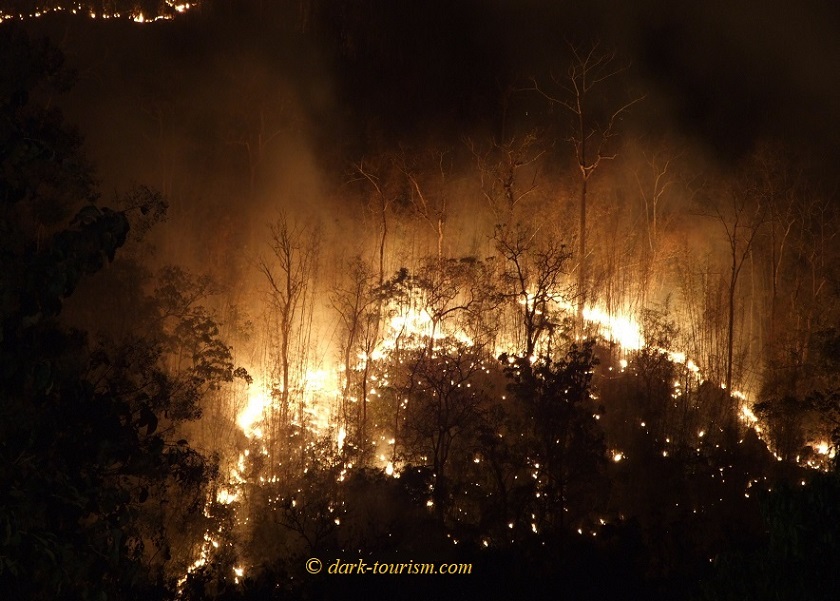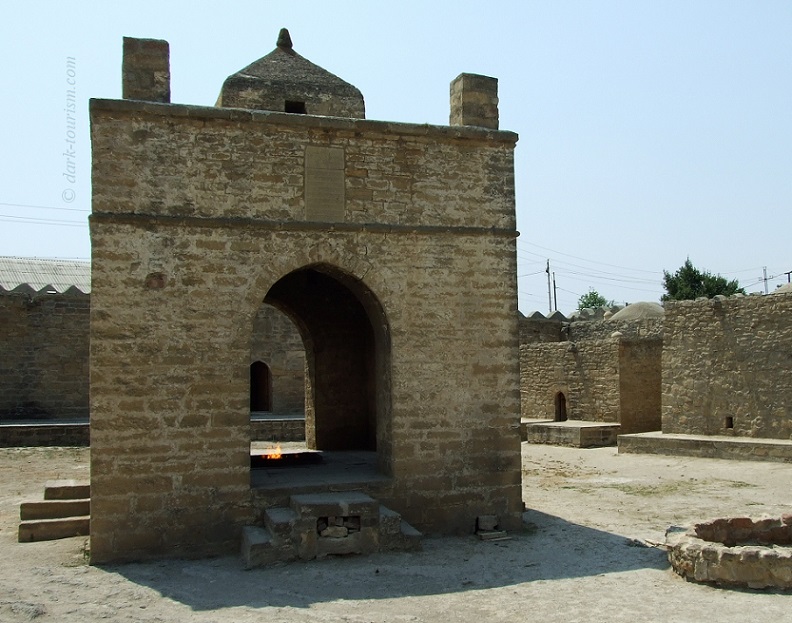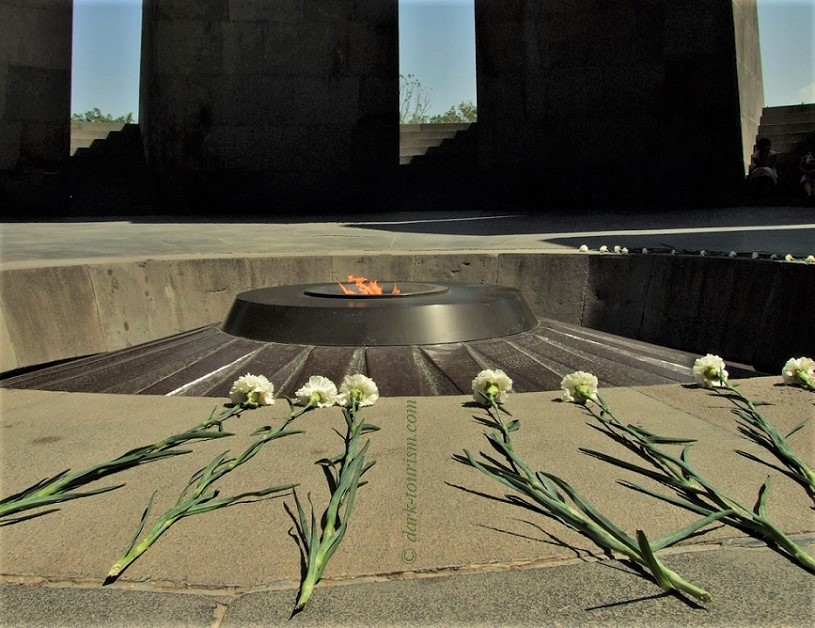As indicated at the end of last week’s blog post about the “Stans”, I now give you a themed post next, namely DT & Flames. It’s a topic that ran a couple times in the theme polls over the past 18 months (here, here and here) but never won. Now I’m just posting it anyway. And that’s because it follows on so neatly from the parts about the Darvaza flaming gas crater in Turkmenistan that was featured in last week’s post, and included photos like this one:

This is possibly the No.1 DT site in the world involving flames, but instead of repeating the Darvaza photos from last week here all over again, I’ve had a look around the world as it were for other flames. In fact I found quite a few in my archives and had to be selective.
This next one also features a crater, but in this case it’s a volcano’s, namely Halema’uma’u, the main crater of the huge Kilauea volcano system on Big Island Hawaii:

This was taken at night in August 2015 when Halema’uma’u had an active lava lake in its crater, bubbling and flaming away in an infernal fiery pit. You can’t see any flames or lava directly here. What looks like fire is actually only the glow from the inferno below also reflected in the plume of gas emitted by the crater.
Things have changed at lot at Kilauea since then. In 2018, lava erupted from new vents and fissures outside the Volcanoes National Park and destroyed much of the housing in the south-east of the island. At Halema’uma’u the whole crater collapsed after its lava had drained away and for a while it seemed that the activity that had been going on continuously since 1983 had finally come to an end. But not too long after, volcanic activity resumed, with fresh lava and even a new lava lake forming at Halema’uma’u. Eruptions have been on and off, and at the time of writing the activity is pausing again and the lava lake has crusted over, but is expected to wake up again.
While such volcanic activity is spectacular and seldomly observable so dramatically as in the above photo and thus a rare thing to behold, other flames are, unfortunately, very common indeed, namely those of forest fires. We all have seen the dramatic footage from the huge forest fires in California and Australia in recent years, but on a smaller scale forest fires happen all the time and are frequently started intentionally, as in slash-and-burn agriculture common in Indonesia.
When I was in Indonesia in 2014 and flew from Banda Aceh to Jakarta, i.e. over the entire length of the island of Sumatra, I could see the layer of smoke above valleys where slash-and-burn was ongoing. The smoke sometimes even reaches all the way to Malaysia. On a much smaller scale I witnessed a wildfire on a slope of an island from the boat that took me back from Komodo Island to Labuan Bajo on Flores after dark. It looked like this:

Being on a boat we didn’t feel threatened by such flames (though the state of the boat itself was a cause for worry!). On an earlier occasion, however, I witnessed a forest fire on a hill above the camp I was staying at in Thailand. These flames were slowly eating their way downhill and towards the camp:

It looked a bit worrying, but camp staff assured me that local farmers had the fire under control and there was no danger. Indeed the fire never got much closer than this in the end.
Natural gas from the ground can also be the cause of natural flames. Unlike at Darvaza where the seeping gas was deliberately ignited, there’s a “fire mountain” in Azerbaijan where gas seeping from the ground ignited accidentally many decades ago. It has kept flaming ever since. It’s called Yanar Dağ in Azeri and has become a minor tourist attraction of the region of Absheron north of Baku and was included in my tour of the peninsula as its end point when I was in the Caucasus in 2010:

In front of the flames is a small amphitheatre-like sitting area where you can take a seat and stare into the flames. It’s indeed quite mesmerizing (though nowhere near as on the same scale as Darvaza).
Azerbaijan, like neighbouring Iran, has a historical-religious connection with fire: Zoroastrianism, in which fire is worshipped. To the east of Baku, also in the Absheron region, is an old “fire temple” called Ateshgah (Atəşgah in Azeri), which was abandoned in the late 19th century and has meanwhile also become a tourist attraction. It includes a small museum where there’s a scale model illustrating what the central fire shrine once used to look like:

Originally, the flames even shot out of those four corner chimney stacks. Today, the real thing looks much less dramatic:

Owing to the advent of the oil industry around Baku, with its ubiquitous drilling all over the region, the gas pressure level sank and the fires went out at Ateshgah. The central flame inside the shrine has been revived, though, but its gas source is no longer natural but piped in from the city’s domestic gas supply.
Pipes are also used to channel sulphurous gas at the sulphur mine inside the crater of Ijen volcano on Java, Indonesia. This is done in order to condense and liquefy the pure sulphur and then solidify it, cut it up, and sell it. For that purpose the sulphur is ignited, but during daylight you can’t actually see the flames, as evidenced by this photo of the mine taken after sunrise:

However, come before daybreak, in the middle of the night, and you can witness the flames – burning a deep blue that you can indeed only see in the dark. This is why our guide took us there at night and we descended the inner wall of the crater at about two in the morning and found this scene:

In the foreground you can see mine workers with torches and the blue sulphur flames in the background. Getting closer is possible, provided you wear a suitable protective mask against the really acrid sulphurous smoke emitted here. But photographing the flames is difficult – cranking the ISO up makes the image too noisy (grainy) but long exposures with a tripod and at lower ISO makes the flames and smoke go fuzzy because they are of course constantly moving. Here’s a compromise image that I managed to get:

Flames are also used for ceremonial purposes. When I was in San Pedro de Atacama in northern Chile over New Year in 2011/12, I witnessed the apparently traditional burning of effigies (I don’t know of whom) at midnight on New Year’s Eve:

(This photo has featured on this blog once before, namely in the DT & New Year’s Eves post.)
The most common ceremonial flames, though, are those “eternal flames” at military memorials and significant graves (real or symbolic). Here’s the one burning at the grave of John F. Kennedy and his former wife Jackie at Arlington outside Washington D.C.:

Such “eternal flames” were especially widespread in the former Eastern Bloc. Most of these have long been extinguished since the collapse of communism and the dissolution of the USSR, but a few are still burning, especially in Russia. Possibly the most significant is the one at the Tomb of the Unknown Soldier right by the Kremlin wall in Moscow:

I’ve seen numerous eternal flames but here I have to be especially selective and pick out only the best … and if size matters, then the most impressive eternal flame I’ve ever seen was this one in front of the huge war memorial towering above the harbour of the northern Russian city of Murmansk (same photo as the featured one at the top of this post):

Here the flames shot up over three feet (1m) high and you could really feel the heat standing near it!
And as far as the setting goes, this pathos-laden memorial in Volgograd (the former Stalingrad) is surely remarkable too:

This ice-cream-cone-like sculpture with the flame at the top stands inside the circular Hall of Glory, which is part of the large memorial complex at Mamayev Kurgan.
Outside Russia, another fairly impressive example is this one, part of the war memorial in Panfilov Park in Almaty in the former Soviet republic of Kazakhstan:

Another eternal flame takes us back to Azerbaijan, now to the capital city Baku. Here the large memorial complex called Martyrs’ Lane (Şəhidlər Xiyabanı in Azeri) culminates in a Zoroastrian-temple-like structure, at the centre of which burns another huge eternal flame:

In the neighbouring country of Armenia, Azerbaijan’s as well as Turkey’s arch-enemy, there’s a memorial complex in the capital Yerevan called Tsitsernakaberd, which commemorates the Armenian genocide perpetrated by the Ottoman Empire in 1915. Again an eternal flame burns at the centre of the main memorial monument:

This is a close-up of the flame and the flowers laid on the rim – zoomed out a bit you can see more of the monumental structure of the monument … and one of the old ladies keeping the place tidy:

But so much for ceremonial flames. Fires of course also serve quite practical purposes, especially for keeping warm, e.g. at campfires out in the open. I’ve always loved gazing into campfires, from childhood onwards, when our family would often be in the great outdoors and my Dad was good at building campfires and keeping them going. On some of my DT travels there have also been campfires. Here’s an example from Chambal River Lodge in India:

When I was in Rwanda, primarily to visit the various memorials to the Rwandan genocide, we also included one mountain gorilla trek (which still is one of the highlights of all wildlife watching I’ve ever undertaken), and at the lodge where we stayed overnight high in the mountains it got pretty cold at night, so we had a little fireplace in our room that the staff had put to use … and I found I had trouble keeping the fire going – I guess I didn’t get that campfire gene passed on to me from my Dad …

At the “Tree House Village” near Samana in the Dominican Republic (don’t just think of that country as a beach holiday destination – it has dark history in spades too!) they had a sort of fire in the public bar/restaurant area that I’d never seen anywhere else before or after. It was like a little shallow pond into which valves released gas that ignited atop the water and flickered away as if floating:

Fire is of course also used for cooking, nowadays primarily on gas stoves. In late 2016 on my India round trip I visited the Golden Temple in Amritsar, the holy of holies of the Sikh religion in the north-western province of Punjab, and in the huge communal kitchen area I witnessed the use of enormous karais/woks on gas flames for cooking veg curry for all those thousands of pilgrims:

On a much smaller scale, when I accompanied my wife on a visit to an old friend in Yaroslavl during our trip to Russia in 2017, we went out to his dacha (weekend house in the countryside) one day, where his son prepared us a lunch of grilled aubergine skewers over an open fire. So yet more culinary flames:

And finally, here’s a fake flame. As the Eiffel Tower in the background gives away clearly, it is located in Paris. It’s apparently a full-scale replica of the gilded flame sculpture that is held aloft by the Statue of Liberty in New York City. The statue was a gift from France, this replica, named “Flamme de la Liberté” or ‘Liberty Flame’, was erected in 1987 and was a gift to France from the US on the centenary of the inauguration of the Statue of Liberty:

The reason this spot is relevant to dark tourism is because it’s near the entrance to the road tunnel in which Princess Diana of Wales had her fatal car accident on 31 August 1997. The flame subsequently was turned into a Diana remembrance shrine by members of the public, who visited in their hundreds daily in the wake of the accident to leave flowers, mementoes, poems and even messages scratched into the surface of the flame. Hence it later had to be restored and better protected. It’s still a pilgrimage spot of sorts.
But with this I shall bring this post to a close. 25 flames is generous enough, I think 😉




